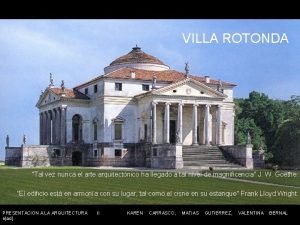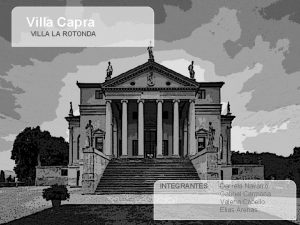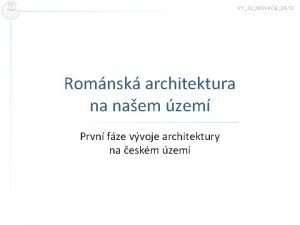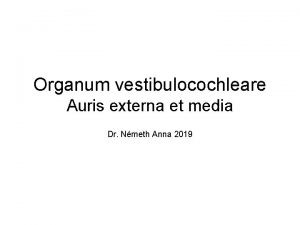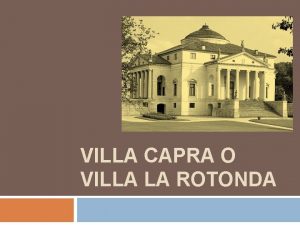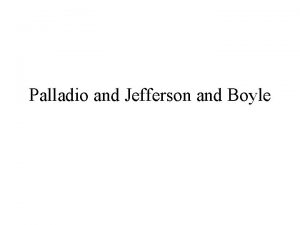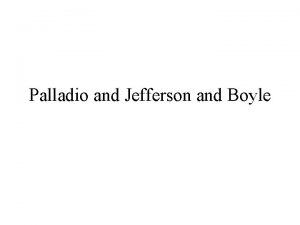VILLA CAPRA LA ROTONDA Villa Capra La Rotunda






- Slides: 6

VILLA CAPRA “LA ROTONDA” • Villa Capra "La Rotunda" is a Renaissance villa just outside Vicenza, northern Italy, designed by Andrea Palladio. • The proper name is Villa Almerico-Capra. • It is also known as La Rotonda, Villa Rotunda, Vill a La Rotonda, and Villa Almerico.

INSPIRATION • In 1565 a priest, Paolo Almerico, on his retirement from the Vatican, decided to return to his home town of Vicenza in the Venetian countryside and build a country house. • This house, later known as 'La Rotonda', was to be one of Palladio's best-known legacies to the architectural world. • Villa Capra may have inspired a thousand subsequent buildings, but the villa was itself inspired by the Pantheon in Rome.

DESIGN • The site selected was a hilltop just outside the city of Vicenza. This sophisticated building was designed for a site which was, in modern terminology, "suburban". • The design is for a completely symmetrical building having a square plan with four facades, each of which has a projecting portico. The whole is contained within an imaginary circle which touches each corner of the building and centres of the porticos.

DESIGN • The name La Rotonda refers to the central circular hall with its dome. To describe the villa, as a whole, as a 'rotonda' is technically incorrect, as the building is not circular but rather the intersection of a square with a cross. • Each portico has steps leading up, and opens via a small cabinet or corridor to the circular domed central hall • The design reflected the humanist values of Renaissance architecture. In order for each room to have some sun, the design was rotated 45 degrees from each cardinal point of the compass. • Each of the four porticos has pediments graced by statues of classical deities. The pediments were each supported by six ionic columns.

INTERIOR • The highlight of the interior is the central, circular hall, surrounded by a balcony and covered by the domed ceiling; it soars the full height of the main house up to the cupola, with walls decorated in trompe l'oeil. • Abundant frescoes create an atmosphere that is more reminiscent of a cathedral than the principal salon of a country house.

LANDSCAPING • From the porticos wonderful views of the surrounding countryside can be seen; this is no coincidence as the Villa was designed to be in perfect harmony with the landscape. • This was in complete contrast to such buildings as Villa Farnese of just 16 years earlier. • Thus, while the house appears to be completely symmetrical, it actually has certain deviations, designed to allow each facade to complement the surrounding landscape and topography. Hence there are variations in the facades, in the width of steps, retaining walls, etc. • In this way, the symmetry of the architecture allows for the asymmetry of the landscape, and creates a seemingly symmetrical whole. The landscape is a panoramic vision of trees and meadows and woods, with the distant Vicenza on the horizon.

